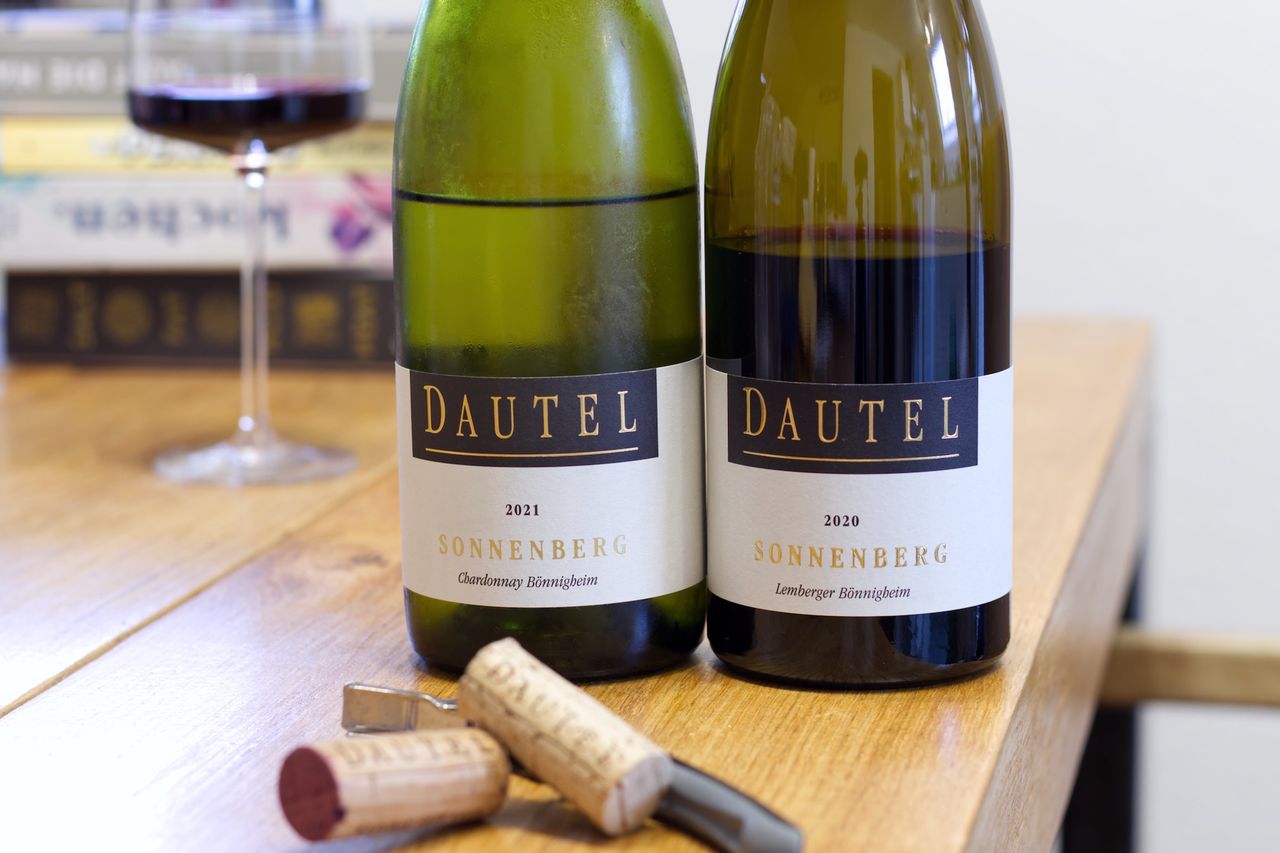Two Bottles Dautel
We drink a bottle of Chardonnay 2021 from Dautel from Württemberg and a bottle of Lemberger 2020 from the Bönnigheimer Sonnenberg.

Not only do we have two bottles of Dautel in front of us, there are also two bottles of Bönnigheimer Sonnenberg. This is one of the two Erste Lage vineyards where Christian Dautel produces wine, alongside Besigheimer Wurmberg. Below the Erste Lage wines, you’ll find the wines classified as Gutswein and Ortswein, and above, the Grosses Gewächs. Lemberger and Pinot Noir grow on reed sandstone and gypsum keuper in the Sonnenberg vineyard, according to the winery’s website. However, this information is not up to date because the Chardonnay also comes from there. It’s worth noting that Chardonnay is not mentioned at all as a grape variety in any single site description, which is quite amusing since Chardonnay is the reason why Dautel’s wines have caught my attention in recent articles. On the other hand, the top-tier chardonnay, which used to be labeled as Chardonnay -S-, has only recently been released under its site name, Besigheimer Niedernberg. The website is probably just slightly outdated. Since two bottles are better than one, and Lemberger is always a good choice, we decide to enjoy that as well. In Bönnigheim, just south of Heilbronn, you can also find the winery itself, of which we had the opportunity to sample a bottle of Riesling some time ago. The Dautel family has a wine-growing tradition dating back to the 16th century, and Christian is now the 14th generation in this lineage. His father, Ernst, played a significant role in laying the foundation for their current success, initially by planting Chardonnay and aging wines in small barrels. This journey culminated in their admission to the VDP in 1999, and eventually, Christian took over the reins in 2013 as the current generation.
The Chardonnay initially presents itself as aloof, cool, and spicy. There are subtle wood notes and hints of nuts, which briefly give the impression that I might have opened the bottle too early. But really only very, very briefly, because the amount of juiciness that then washes over the tongue and along the cheeks is impressive. Of course, there’s structure, a touch of creamy stone fruit, and a subtle wood presence, but one must pay close attention to notice these nuances as the wine easily slips away from the glass. I can’t remember the last time I experienced this level of pronounced juiciness in combination with a Chardonnay. I don’t want to say the wine smells a bit stiff in comparison to how it drinks, but it certainly doesn’t smell of Saufwein. While it does drink like one. And this is actually an understatement. And it’s also true that I like to smell cool spicy Chardonnays just like this one. They just normally last longer in the glass. Afterward, we exercise some restraint, refrigerating about a third of the bottle, as I’m curious to see how the wine evolves overnight.
Indeed, the wine becomes softer and fruitier on the nose, though its drinkability remains unchanged. Only the attempt to drink a glass with pasta with long aged sheep cheese was a complete failure. Food and wine completely ruined each other. Nothing that wine or food, which are great on their own, could do anything about. Grilled fish as recommended in the webshop would have been a better partner I guess. Something to consider next time.
One interesting observation is that the Lemberger, in contrast to the Chardonnay, makes a bold entrance immediately upon opening. This is intensely fruity, rather dark, with blueberries and other forest berries running through it and almost sweet with all that fruit in the nose. Behind it is a fine woody spice that can just barely stand up to the fruit. And the Lemberger is also really juicy. There is tannin, but it passes by velvety soft and then is also overtaken by the fruit on the tongue. This is certainly one of the fruitiest Lembergers I have had in the glass lately, just by smelling alone. And once again that ends up being a sentence I am almost reluctant to write because a high level of fruit is so often seen as boring or not desirable. That is of course nonsense. First, because the spice and also the spices that are also there, offer a great frame, so that it never becomes too fruity, and secondly because this kind of fruit could fill the evening all by itself.
However, on the second evening, the spiciness takes the lead and stands on par with the fruitiness. This elevates the overall juiciness to another level, at least in terms of perception. Although I am convinced the objective mouthfeel doesn’t undergo substantial changes, the aromatic transformation is notable. But since smell contributes very much to how we taste, these changes are always exciting to monitor. The increased spiciness complements the wine just as well as the captivating fruitiness experienced on the first evening. But if I had to choose, I’d wish for the return of the overwhelming fruit. That was just too beautiful.